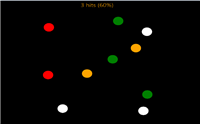Contents tagged with motion perception
-

This illusion nicely demonstrates how motion integration is performed by our visual system. At the start you perceive a global wave motion across to the entire field. When real trajectories of moving dots are shown, you can see that they simply rotate clockwise with a small phase shift to each other. The dots produce so-called local motion cues for the visual system, which automatically integrates them into a complex motion pattern. Note that when trajectories are shown, a percept of the global motion is much weaker, because an extra information increases possible relevance of the local motion.
This demo is made just with few code lines in EventIDE using GDI+ drawing functions.
Submitted by on 03 Jul 2013
-

MOT is a famous experimental paradigm used to study how our visual system tracks multiple moving objects. The paradigm was developed by Pylyshyn and Storm in 1988 and subsequently adapted in numerous studies. The common finding over these studies is that there is a limited number of moving objects that the visual system can track in a parallel.
There are two prominent theories explaining a limited capacity in the MOT task: the earliest FINST theory (Pylyshyn 1989, 1994) postulating that brain has a limited (around 4) of tracking 'pointers' that can be attached to moving objects (Pylyshin et al). Another theory, proposed and tested by Yantis in 1992 , suggests that all tracking objects are grouped into one higher order group with each object making a vertex in a virtual polygon.
We developed two EventIDE templates of the MOT task, with two types of participant's response taken after end of a motion. The first template replicates the original Pylyshyn 's paradigm, where a Yes-No response indicates whether a single probed object belongs to a subset of tracking objects. The second template allows participant to indicate all tracking objects with a mouse. The later response type became a standard in the MOT recent studies.
The template contain a code that generates unpredictable trajectories for occlusion-free motion of multiple objects. Trajectory generation is a random process controlled by several initial parameters that can be customized. In addition, the templates demonstrate how to use recurrent events to create a time-precise animation with EventIDE.
Submitted by on 16 Dec 2012
